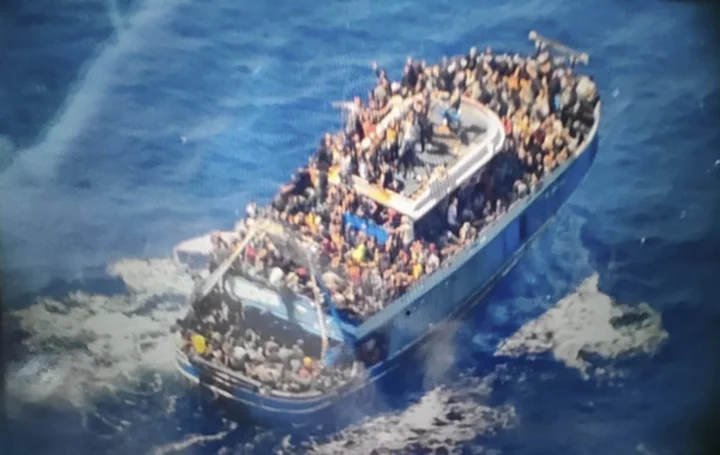ROME (AP) — Wednesday's deadly shipwreck off southern Greece, involving a large boat carrying migrants that capsized after apparently rebuffing offers of help, is just the latest case of smugglers packing vessels full of desperate people willing to risk their lives to reach continental Europe.
The trip from Libya or Tunisia through the Central Mediterranean and north to Europe is the deadliest migratory route in the world, according to the U.N.’s International Organization of Migration.
Here’s a look at situation in the Mediterranean and some of the particulars of the latest tragedy:
WHAT HAPPENED?
Greek coast guard, navy and merchant vessels and aircraft launched a vast search and rescue operation after the fishing boat capsized and sank early Wednesday some 75 kilometers (45 miles) southwest of the southern Peloponnese peninsula.
So far, 79 bodies have been recovered and 104 people have been rescued. It was unclear how many were missing, but some initial reports suggested hundreds may have been aboard. If that is confirmed, the wreck could become the deadliest so far this year.
WHAT ABOUT THE OFFERS OF HELP?
The coast guard said the boat rebuffed several offers of assistance by both coast guard and merchant ships in the area starting Tuesday. The agency said in a statement that the ship’s captain “wanted to continue to Italy.”
However, Alarm Phone, a network of activists who run a hotline for migrant boats in distress, said they had been contact with migrants on the vessel and there were pleas for help.
Vincent Cochetel, the U.N. High Commissioner for Refugees' special envoy for the Western and the Central Mediterranean, tweeted that “this boat was unseaworthy & no matter what some people on board may have said, the notion of distress cannot be discussed.”
Many migrants look to bypass Greece and reach Italy, where they can more easily continue their journeys north to family and other migrant communities elsewhere.
Had the migrants been rescued by Greek authorities, they would have to trek through the often hostile Balkans to reach Western or Northern Europe. The route north from Italy is closer and often more accessible.
WHAT IS GREECE’S MIGRATION POLICY?
Most migrants to Greece cross from Turkey, either reaching the nearby eastern Greek islands in small boats or by crossing the Evros river — known as the Meric in Turkey — which runs along the land border.
Crossings have fallen sharply in recent years as Greece stepped up sea patrols and built a border fence along the Evros. But the country faces persisting allegations from migrants, human rights groups and Turkish officials that it returns migrants back across the border to Turkey, illegally preventing them from claiming asylum. Athens has repeatedly denied that.
Alarm Phone blamed Greece’s migration policy for the shipwreck, saying Athens has become “Europe’s shield” to deter migration. The Greek coast guard defended its actions, saying it had accompanied the vessel even after it refused assistance and then launched the search and rescue operation after the boat capsized.
WHAT ARE THE TRENDS IN MIGRANT ARRIVALS IN THE MEDITERRANEAN?
Italy has recorded the vast majority of “irregular” arrivals in Europe so far this year, 55,160. That is more than double the 21,884 who arrived in the same period in 2022, and 16,737 in 2021. People from Ivory Coast, Egypt, Guinea, Pakistan and Bangladesh account for the most arrivals this year, according to Interior Ministry data.
U.N. refugee officials note that overall numbers of migrants seeking to come to Europe this way have been on the decline, to an average of around 120,000 annually.
In addition to the deadly Central Mediterranean route, the Western Mediterranean route is used by migrants seeking to reach Spain from Morocco or Algeria. The Eastern Mediterranean route has traditionally been used by Syrian, Iraqi, Afghan and other non-African migrants who go first to Turkey and then try to reach Greece or other European destinations.
HOW DANGEROUS IS THE MEDITERRANEAN?
Even before Wednesday’s deaths, at least 1,039 people were known to be missing from Central Mediterranean crossings this year. The real figure is believed to be far higher given the likelihood that some wrecks were never recorded. Overall, the International Organization of Migration has tallied more than 27,000 missing migrants in the Mediterranean since 2014.
WHAT HAVE BEEN SOME OF THE WORST DISASTERS?
On April 18, 2015, the Mediterranean’s deadliest known shipwreck occurred when an overcrowded fishing boat collided off Libya with a freighter that was trying to come to its rescue. Only 28 people survived. At first it was feared the hull held the remains of 700 people. Forensic experts who worked to identify the dead concluded in 2018 that there were originally 1,100 on board.
On Oct. 3, 2013, a trawler packed with more than 500 people, many from Eritrea and Ethiopia, caught fire and capsized within sight of an uninhabited islet off the southern Italian island of Lampedusa. Local fishermen rushed to try to help save lives. In the end, 155 survived and 368 people died.
Another shipwreck occurred just a week later on Oct 11 farther out at sea south of Lampedusa. The disaster has become known in Italy as the “slaughter of children,” for the 60 children among the more than 260 people who died. In 2017 the Italian newsweekly L’Espresso published audio recordings of the migrants’ desperate calls for help and Italian and Maltese authorities seemingly delaying the rescue.
HOW HAS MIGRATION DIVIDED EU NATIONS?
Mediterranean countries have for years complained that they bear the brunt of receiving and processing migrants and have long demanded other countries step up and take them in.
Poland, Hungary and other Eastern European nations have repeatedly refused an EU plan to share the burdens of caring for migrants. But after years of bickering, EU leaders last week said there was a breakthrough in negotiations for a new migration and asylum pact.
Human rights groups say the EU has been outsourcing migrant rescues to the Libyan coast guard, which returns them to horrific camps where many are subjected to beatings, rape and other abuse. The EU and member states have also struck agreements with other North African nations to improve their border control and stop migrant boats from reaching Europe.
___
Follow all AP stories on global migration at https://apnews.com/hub/migration,









